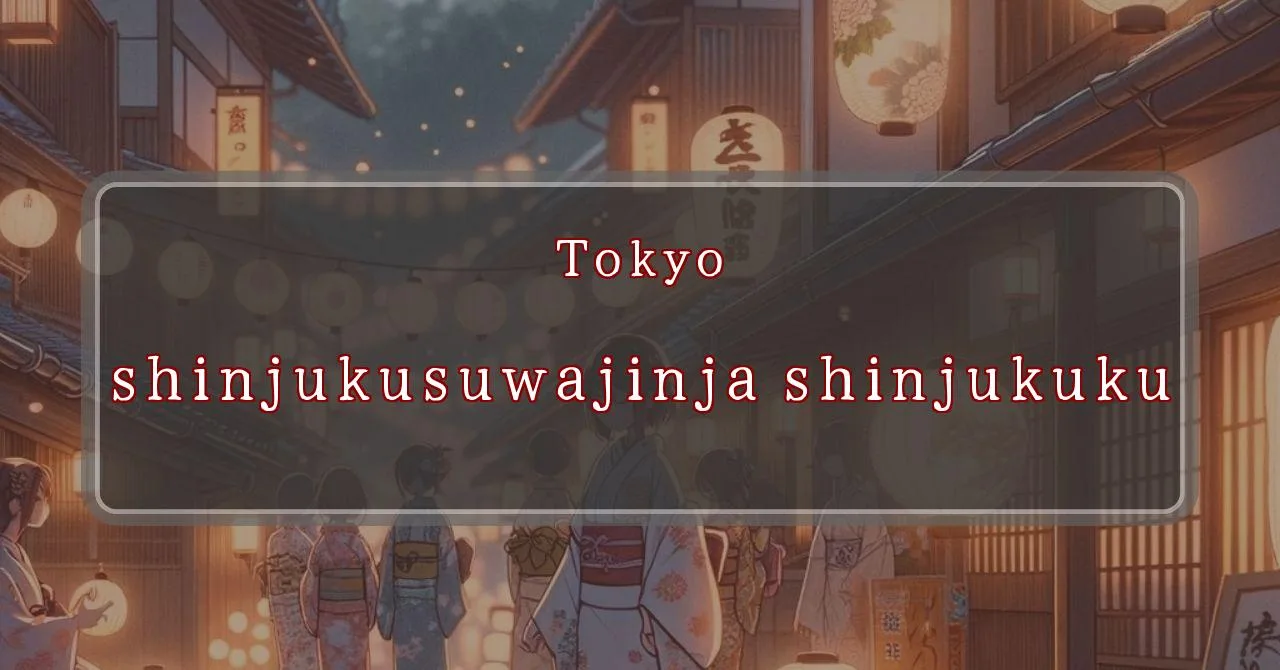Enchanting melodies and vibrant hues await at Shinjuku Suwa Shrine.
Basic Information
Discover the allure of Shinjuku Suwa Shrine, a sacred site steeped in history and revered as the guardian deity of the Takada-no-baba area.
- Address: 1-12-6 Takadanobaba, Shinjuku-ku, Tokyo 169-0075
- Phone Number: 03-3209-3835
- Access: A 10-minute walk from Takadanobaba Station on the JR Yamanote Line or Tozai Subway Line, or a 1-minute walk from Nishi-Waseda Station on the Tokyo Metro Fukutoshin Line.
- Festival Days: August 27th, 2024
Main Events and Attractions of the Festival
Immerse yourself in the vibrant festivities of the Shinjuku Suwa Shrine Festival, where a myriad of captivating events and attractions await.
Mikoshi Procession
Witness the grandeur of the Mikoshi Procession, a highlight of the festival. Elaborately decorated portable shrines, known as mikoshi, are carried through the streets by local residents, accompanied by lively music and traditional dance performances.
Shishimai Dance
Marvel at the mesmerizing Shishimai Dance, a traditional lion dance performed by skilled dancers. The lion’s movements are believed to bring good luck and ward off evil spirits, creating an enchanting spectacle for all.
Taiko Drumming
Feel the pulse of the festival as the thunderous beats of Taiko drums reverberate through the air. Talented drummers perform captivating rhythms, adding an energetic and exhilarating atmosphere to the celebration.
Food Stalls
Indulge in a delectable array of culinary delights at the festival’s food stalls. From traditional Japanese delicacies to modern treats, there’s something to satisfy every palate. Savor the flavors of the region and immerse yourself in the local food culture.
Cultural Performances
Experience the rich cultural heritage of the region through captivating performances. Traditional music, dance, and theater showcase the artistry and creativity of local performers, providing a glimpse into Japan’s vibrant performing arts.
Blessings and Deities
Discover the divine blessings and deities revered at Shinjuku Suwa Shrine, a sanctuary steeped in history and spiritual significance.
- Deities: The shrine enshrines three deities: Takeminakata-no-Mikoto, the god of martial arts and agriculture; Ookuninushi-no-Mikoto, the god of nation-building and prosperity; and Kotosironushi-no-Mikoto, the god of industry and commerce.
- Blessings: Devotees seek blessings for various aspects of life, including good health, success in business, bountiful harvests, and harmonious relationships.
Origin and History
Unravel the captivating history of Shinjuku Suwa Shrine, a tale that spans centuries and intertwines with the rich tapestry of Japanese culture.
- Ancient Roots: The shrine’s origins can be traced back to the early Heian period (794-1185), making it one of the oldest shrines in the Shinjuku area.
- Tokugawa Clan’s Devotion: During the Edo period (1603-1868), the shrine gained prominence under the patronage of the Tokugawa clan, who revered it as a guardian deity.
- Imperial Recognition: In the Meiji era (1868-1912), Emperor Meiji bestowed a sacred object upon the shrine, further elevating its status.
Tips and Notes for Visitors
Ensure a fulfilling and respectful visit to Shinjuku Suwa Shrine by following these helpful tips and guidelines.
- Etiquette: When approaching the shrine, purify your hands and mouth at the chozuya (ablution pavilion) and bow respectfully before entering the main hall.
- Photography: Photography is generally permitted within the shrine grounds, but it’s essential to refrain from taking pictures during ceremonies or when other visitors are engaged in prayer.
- Festivals and Events: The shrine hosts several festivals and events throughout the year, including the lively summer festival in August. Check the shrine’s website or local tourism information centers for details.
Parking Information
For those arriving by car, limited parking is available near Shinjuku Suwa Shrine. However, it’s recommended to utilize public transportation or consider alternative parking options in the surrounding area.
- Public Transportation: The shrine is conveniently accessible via public transportation. Take the JR Yamanote Line or Tozai Subway Line to Takadanobaba Station and walk for approximately 10 minutes.
- Nearby Parking Facilities: There are several parking lots and garages within walking distance of the shrine. Please inquire with local businesses or utilize online parking reservation services for availability and rates.
Popular Stalls and Food Carts in Recent Years
| Type of Stall | Description |
|---|---|
| Takoyaki | A staple at Japanese festivals. Characterized by a crispy outside and a creamy inside. |
| Jaga Butter | A simple yet popular snack of hot potatoes lavishly topped with melted butter. |
| Baby Castella | Small castella cakes, sweet and fluffy treats enjoyed by children and adults alike. |
| Grilled Ayu with Salt | Fresh ayu fish grilled whole with salt, a savory taste of Japanese summer. |
| Shaapin | A unique gourmet item influenced by foreign cuisine, with a chewy skin wrapping the filling. |
| Okonomiyaki | A Japanese grilled dish where you often choose your own ingredients for a personalized flavor. |
| Cotton Candy | A fluffy, sweet snack that’s extremely popular with children. |
| Chocolate Banana | A banana coated in chocolate, a fun and visually appealing dessert. |
| Kushiyaki | Various types of ingredients skewered and grilled, an easy-to-enjoy snack. |
| Yakisoba | Fried noodles mixed with a special sauce, a fast food favorite in Japan. |



